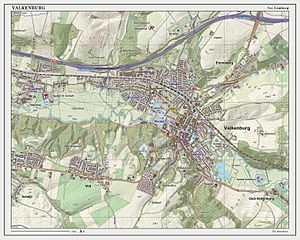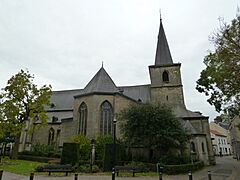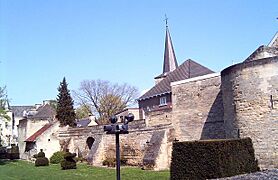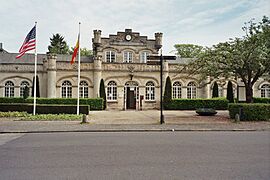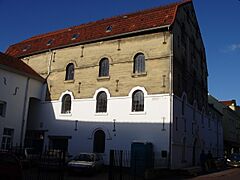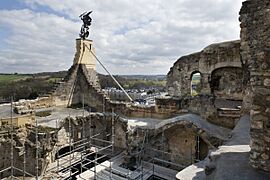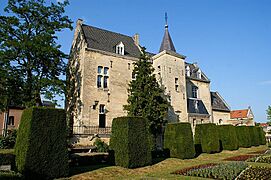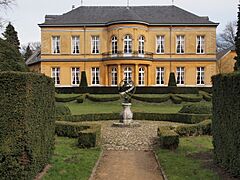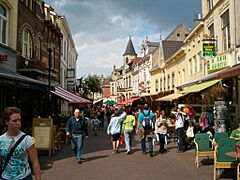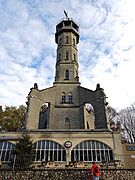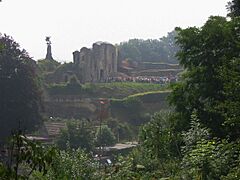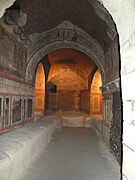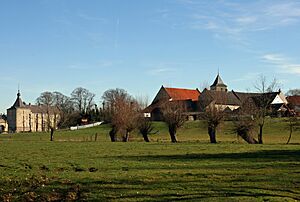Valkenburg aan de Geul facts for kids
Quick facts for kids
Valkenburg aan de Geul
Valkeberg aan de Geul
|
|||
|---|---|---|---|

Valkenburg city centre
|
|||
|
|||
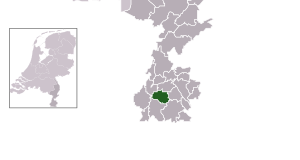
Location in Limburg
|
|||
| Country | Netherlands | ||
| Province | Limburg | ||
| Government | |||
| • Body | Municipal council | ||
| Area | |||
| • Total | 36.92 km2 (14.25 sq mi) | ||
| • Land | 36.73 km2 (14.18 sq mi) | ||
| • Water | 0.19 km2 (0.07 sq mi) | ||
| Elevation | 73 m (240 ft) | ||
| Population
(May 2014)
|
|||
| • Total | 16,650 | ||
| • Density | 453/km2 (1,170/sq mi) | ||
| Demonym(s) | Valkenburger | ||
| Time zone | UTC+1 (CET) | ||
| • Summer (DST) | UTC+2 (CEST) | ||
| Postcode |
6300–6305, 6325, 6340–6342
|
||
| Area code | 043 | ||
Valkenburg aan de Geul is a town in the southeastern province of Limburg in the Netherlands. Its name comes from the main town, Valkenburg, and the small Geul river that flows through it.
Contents
History of Valkenburg
Valkenburg's history often involves battles and takeovers, especially around Valkenburg castle. This castle was home to the counts of Valkenburg. In 1672, Dutch troops led by William III destroyed the castle to stop French armies from capturing it. It was never rebuilt after that.
Valkenburg as a Tourist Spot
In the 1800s, Valkenburg became a popular holiday spot. This was because of its beautiful natural surroundings. Tourism grew even more after a railway opened in 1853. Valkenburg railway station is the oldest train station still in use in the Netherlands.
In the early 1900s, a Dutch architect named Pierre Cuypers lived in Valkenburg. He helped tourism by designing a hotel and an open-air theater. He even created a copy of the catacombs of Rome underground. He also worked on restoring the old church and designing tombs in a nearby graveyard.
Valkenburg During World War II
During the Second World War, Nazi-Germany occupied Valkenburg for over four years. American soldiers from the 30th Infantry Division freed the town on September 17, 1944. The people of Valkenburg welcomed them with tulips and bread.
Modern Valkenburg
Today, Valkenburg is no longer a fortified town. However, it has kept much of its historical charm. The town still hosts over a million overnight visitors each year. The local government wants to attract "quality tourism" now. They have a plan called Vestingstad Valkenburg (Fortification Town Valkenburg). This plan includes restoring old city gates and rebuilding a 14th-century gate called Geulpoort. They also rebuilt the defensive moat. The town's shopping area was also updated around 2017.
In July 2021, the Geul river flooded. This caused a lot of damage to bridges and buildings in the town center.
Main Attractions in Valkenburg
Valkenburg is famous for its tourist spots, houses made of chalk (called mergel), and its hilly countryside. Here are some of the main places to see:
- Valkenburg castle: Only ruins of this old castle remain today.
- Other castles: There are several other castles and grand homes along the Geul river.
- Oud-Valkenburg: This small village along the Geul river has a beautiful old church. It also has two castles, Genhoes and Schaloen, and historic farmhouses. All these buildings are made from local marlstone.
- Watermills: There are several old watermills, with two in the old town.
- City walls and gates: Parts of the old city walls and two of its three gates still stand. The third gate, Geulpoort, was rebuilt in 2014.
- Saint Nicolas church: This is a Gothic church in Valkenburg with old wood carvings.
- Saint Gerlachus church: Located in nearby Houthem Sint-Gerlach, this church has colorful Baroque paintings on its marl walls.
- Marl quarries: These are old mines, mostly made by people. You can take guided tours inside them. Some have interesting drawings and sculptures. One quarry has been made to look like the catacombs of Rome, and another looks like a coal mine. In winter, Christmas markets are held in some quarries.
- Wilhelminatoren: This is a 30-metre-high (98-foot) viewing tower on top of a hill. You can reach it by an aerial lift from the town below.
- Thermae 2000: A place with saunas and wellness treatments.
- Holland Casino: A casino with a large park around it called Kuurpark.
- Amusement parks: There are two amusement parks, one of which focuses on popular fairy tales (Sprookjesbos).
The area around Valkenburg is known for its beautiful nature and historic buildings. It's a great place for walks or bike rides, even though it's quite hilly.
Historic Buildings in Valkenburg
Castles and Grand Homes in Valkenburg
Fun Tourist Spots in Valkenburg
Cycling Events in Valkenburg
Valkenburg aan de Geul is famous for its cycling races. The city has hosted the UCI Road Cycling World Championship five times. These were in 1938, 1948, 1979, 1998, and 2012. Since 2003, the town's Cauberg hill has been the finish line for the Amstel Gold Race. The Tour de France also had a stage finish in Valkenburg in 1992 and 2006.
The Cauberg Cyclo-cross is another bike race that is part of the UCI Cyclo-cross World Cup.
Villages and Hamlets
Besides the main town of Valkenburg, the area includes these villages and hamlets:
- Berg en Terblijt
- Vilt
- Geulhem
- Houthem
- Sibbe
- IJzeren
- Oud-Valkenburg
- Schin op Geul
- Walem
Getting Around Valkenburg
By Car
You can reach Valkenburg aan de Geul by the A79 motorway. This road connects Maastricht to Heerlen.
By Train
Valkenburg aan de Geul has three train stations:
- Valkenburg
- Houthem-Sint Gerlach
- Schin op Geul
These stations are operated by Arriva.
By Bus
Valkenburg aan de Geul is also served by Arriva buses.
Famous People from Valkenburg
- Saint Gerlach (died around 1170), a hermit.
- Beatrice of Valkenburg (c. 1254 - 1277), who became a queen of Germany.
- Pierre Cuypers (1827 – 1921), a famous architect who lived in Valkenburg for some years.
- Erich Wasmann (1859 - 1931), an entomologist (someone who studies insects).
- Jan Hanlo (1912 - 1969), a poet and writer who grew up in Valkenburg.
- Raymond Barion (born 1946), a Dutch artist known for paintings and sculptures.
- Gerlach Cerfontaine (born 1946), a business leader and former CEO of Schiphol Group.
- Marjon Lambriks (born 1949), a soprano singer.
- Rob Delahaye (born 1959), a former professional footballer.
- Camiel Eurlings (born 1973), a politician and business leader for KLM.
- Rob Ruijgh (born 1986), a racing cyclist.
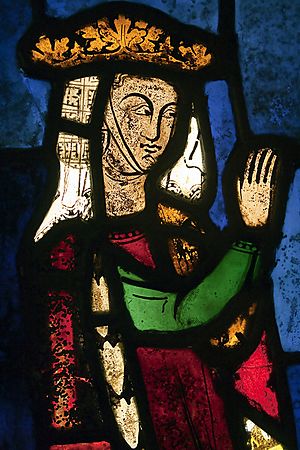
Panorama
See also
 In Spanish: Valkenburg aan de Geul para niños
In Spanish: Valkenburg aan de Geul para niños




